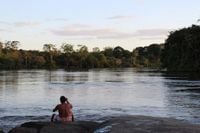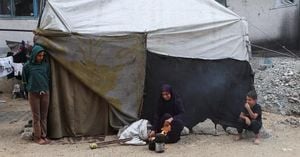Deep in the heart of the Amazon rainforest, a new chapter in the ongoing story of environmental preservation and human well-being is unfolding. According to a study published on September 11, 2025, in Communications Earth & Environment, well-preserved Amazon rainforest on Indigenous lands does far more than protect biodiversity—it also shields people from a host of diseases. This revelation, backed by robust data and decades of Indigenous wisdom, is poised to influence global climate policy as the United Nations climate summit approaches in Belem, Brazil, this November.
The research, led by Julia Barreto and her international team, analyzed data spanning from 2000 to 2019 across the nine countries sharing the Amazon basin. Their findings are as striking as they are timely: areas where forest was set aside for Indigenous peoples—especially those with more than 45% forest cover—experienced significantly lower rates of diseases, including respiratory illnesses like asthma and pneumonia, and zoonotic infections such as malaria. The protective effect, the authors argue, is intricately tied to the integrity of the forest and the legal recognition of Indigenous territories.
“The ‘forest man’ or ‘man forest,’ according to the Indigenous perspective, has always been linked to the reciprocity between human health and the natural environment where one lives,” said Francisco Hernández Cayetano, president of the Federation of Ticuna and Yagua Communities of the Lower Amazon (FECOTYBA), as quoted by the Associated Press. For Hernández and many others, the study validates what Indigenous communities have known for generations: the health of people and the forest are inseparable.
The Amazon basin is home to approximately 2.7 million Indigenous inhabitants, whose territories cover nearly a third of the region’s forested expanse. Traditionally, these lands have been recognized as strongholds of ecological conservation. Recent studies, including this latest one, have highlighted their effectiveness in maintaining forest cover and biodiversity. But Barreto’s research goes a step further, showing that the benefits extend well beyond conservation—directly impacting human health outcomes for both Indigenous and neighboring populations.
The study’s analytical framework was impressively comprehensive. Researchers incorporated epidemiological data on 21 diseases linked to environmental factors, remote sensing imagery to assess forest cover and fragmentation, fire incidence rates, and the spatial extent of Indigenous Territories. By weaving together these disparate threads, the team was able to tease out nuanced relationships between forest landscape dynamics and disease prevalence, mediated by Indigenous stewardship and legal protections.
One of the study’s core revelations is that the health benefits of Indigenous Territories are conditional. In regions where forest cover remains above 45%, the existence of legally recognized Indigenous lands correlates with a marked reduction in disease cases associated with forest fires and zoonotic spillovers. Trees and dense forest ecosystems act as natural air filters, absorbing pollutants and mitigating the impact of smoke from fires. Meanwhile, intact habitats support biodiversity and regulate wildlife populations, reducing the risk of pathogens jumping from animals to humans—a phenomenon that has become all too familiar in recent years.
However, the picture changes dramatically in areas where forests are fragmented or diminished. In these landscapes, the health advantages of Indigenous Territories are muted or even reversed. The study suggests that broken or degraded forests may increase human-wildlife interactions and environmental stressors, eroding the protective buffer that intact forests provide. This counterintuitive outcome highlights the importance of landscape connectivity and forest integrity as prerequisites for leveraging the health benefits of Indigenous stewardship.
The mechanisms at play are complex but increasingly well-understood. Forests absorb air pollutants, reducing exposure to harmful particulates that can trigger respiratory diseases. They also create natural barriers that limit the spread of disease vectors and reservoirs. Indigenous land-use practices, rooted in centuries of traditional knowledge, typically restrict deforestation and maintain ecosystem resilience. By keeping forests whole and vibrant, these communities prevent the encroachment and habitat loss that often lead to increased disease risk.
Legal recognition emerges as a critical factor. The study found that legally protected Indigenous Territories are far more effective at preserving forest cover and resisting pressures from illegal logging, mining, and land grabbing. This legal empowerment not only safeguards the environment but also amplifies the health benefits for people living in and around these forests. As Barreto and her colleagues note, the combination of ecological stewardship and formal legal status is vital for both environmental and public health outcomes.
Outside experts have praised the study for its methodological rigor and global relevance. Kristie Ebi, a health and climate scientist at the University of Washington, described the work as “impressive,” noting its potential to inspire similar research in other parts of the world. Magdalena Hurtado, an anthropology and global health professor at Arizona State University, commended the creative approach to accounting for variables like healthcare access but cautioned against overinterpreting the precision of the findings. “They claim that Indigenous territories only protect health when forest cover is above 40%. And so that feels like, why 40%? Why not 35? Or why not a range?” she asked. Still, Hurtado believes the research opens the door to future studies that could refine and expand on these insights.
James MacCarthy, a wildfire research manager at the World Resources Institute, emphasized that while Indigenous land tenure is crucial for maintaining intact forests, preserving forest outside of Indigenous-stewarded areas is also essential. The study’s broader message is clear: safeguarding the Amazon requires a mosaic of conservation strategies, with Indigenous stewardship at its core.
The timing of this research is no accident. With the UN climate summit set for Belem—often called the gateway to the Amazon—Indigenous communities are expected to play a prominent role in shaping the global climate agenda. For Hernández of FECOTYBA, studies like this one are vital for making “our ancestral knowledge more visible and precise” in the eyes of policymakers and the international community.
The implications extend far beyond the Amazon. As the world grapples with rising rates of zoonotic diseases and the ever-present threat of climate change, the link between environmental health and human health is becoming impossible to ignore. The Amazon, as both a carbon sink and a disease buffer, stands at the intersection of these challenges. Recognizing and empowering Indigenous peoples as stewards of this vital biome is not just a matter of justice—it’s a pragmatic strategy for safeguarding planetary health.
The authors of the study call for reinforcing legal frameworks that defend Indigenous land rights and for integrating Indigenous knowledge into environmental governance. They stress that environmental interventions alone are insufficient without social and legal commitments to Indigenous sovereignty and forest protection. Looking ahead, they advocate for participatory monitoring and decision-making, as well as technological advancements in remote sensing and epidemiological modeling to further refine our understanding of these intricate relationships.
This research, published just as the world’s eyes turn to the Amazon ahead of the climate summit, is a clarion call. It underscores the indispensable role of Indigenous stewardship in sustaining both environmental and human health. As global environmental crises mount, supporting Indigenous Peoples and protecting their lands is emerging as one of the most effective—and necessary—strategies for a healthier, more resilient planet.






